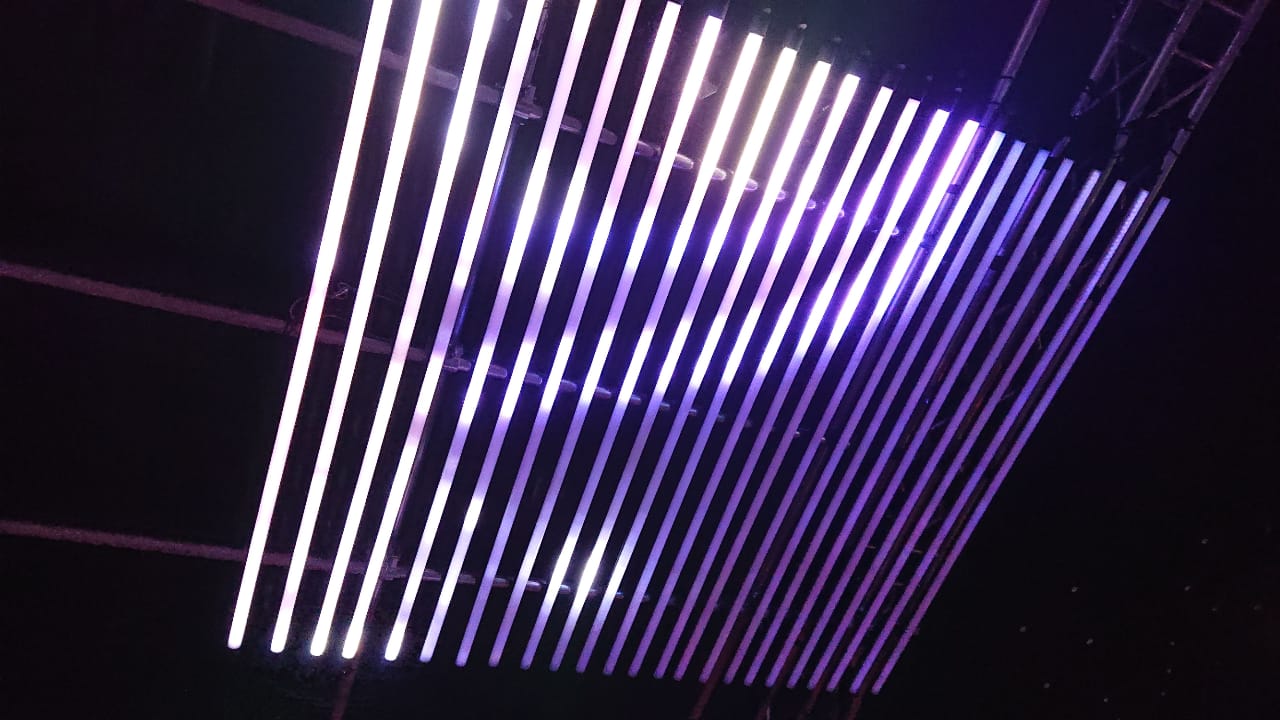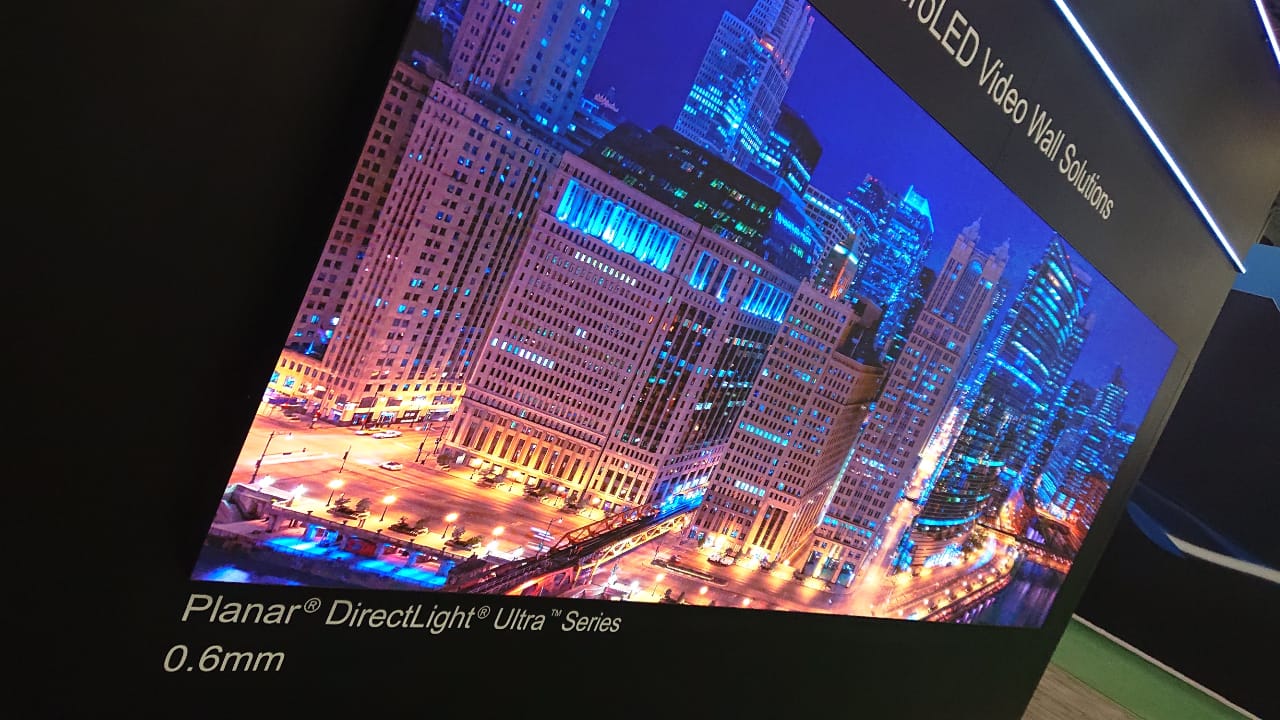
Phil Rhodes consults his notebooks from the LVCC and finds more to say on the subject of LED walls and lights.
The relative absence of giant LED video walls at NAB 2023 was almost as striking as their equally sudden emergence was a year ago. At the 2022 show, a couple of exhibitors showcased giant cove displays in Central Hall, themselves each sufficient to equip a desirable and well-appointed virtual production facility. This year, that all felt rather dialled down.
A fairly large space was taken up, however, by an exhibit demonstrating a working combination of LED video display and image-based lighting equipment from Quasar Science, all brought together by a computer-based DMX controller and described in a lecture delivered by Quasar’s estimable technical expert, Tim Kang. The company has long distinguished itself in the world of LED pixel tubes by specialising in exactly this kind of integration, and it was interesting to see what video can actually look like when mapped onto a block of high-output, high-quality LED lights, and how the related tools feel in use.
The question this answers is one we’ve touched on before, but which isn’t often discussed outside the field: that LED video walls for virtual production don’t actually cast that much light on the scene when they’re properly exposed for the A-camera. There are ways around this, of course; often the frustum (the area specifically viewed by the taking camera) can be controlled independently of the rest of the wall, although introducing large brightness offsets there can create odd effects in reflections as the edge of the frustum moves around with a mobile camera. Doing it with supplementary lighting avoids that problem, at least as much as telltale reflections of that lighting can be avoided.
We see something of the tools required to make this work in the accompanying photos, which show Quasar’s tubes in banks being driven by regions of a live-action background plate. It quickly becomes clear that different section of the background plate might work best with different setups, with different lights driven by different areas, and with different colour and brightness processing. It is, at this stage, a process inevitably involving some manual adjustment, and given the artistry involved in lighting for cinematography, that seems a healthy reality that’s likely to endure.
From panel to monitor?
Meanwhile, those video wall displays panels continue to improve to the point that they’re increasingly becoming plausible as monitors. Okay, that’s still a slight stretch; Planar’s DirectLight Ultra series might have had the tightest numbers at the 2023 show, now achieving 0.6mm, and to put that in context, that’s only a bit more than 42 DPI. Old-school reckoning had it that computer displays were about 72 DPI, which roughly works out to a 320 by 240 image on one of those tiny four-inch CRTs that were used on luggable computers of the 80s. If we imagine that 320 by 240 image on a small desktop CRT, it’d have about the same resolution as that Planar panel, so LED video wall panels now have about the same density as an okayish good computer display of thirty plus years ago.

So it’s nothing to touch a modern cellphone for sheer pixel density, but it’s clear that video wall panels are not only servicing better and better virtual production, they’re also rapidly chasing down computer monitors. One day, we’ll all be running microLED desktop displays. At point six of a millimetre per pixel, a full DCI 4K display only needs to be about eight feet wide, which is smaller than many of the projected displays used in high end grading suites. One manufacturer suggested that the minimum 4K configuration of its LED wall panels would cost about $85,000. Compare that with the latest Barco, if you will. One wonders how well they calibrate…
We’ve already mentioned one of the small disappointments of NAB 2023, but it’s worth talking about it agin briefly in this context: SmallHD’s upcoming 32-inch OLED has died alongside panel manufacturer JOLED. The company was one of the small group of organisations sufficiently intrepid to try manufacturing high-power, high-resolution, high-acreage OLED display panels, and one of an equally select group of organisations to die trying. OLED is hard, and that’s why SmallHD’s design, which was poised on the cusp of launch, will go no further. Why it failed - and whether JOLED’s process and plant will emerge from the situation as a going concern - remains to be seen, although hopes don’t see high.
Camera to cloud via Teradek
And finally, while we’re over in this Creative Solutions area of the market, let’s have a quick chat about Teradek. Everyone loves Teradek and its ability to bat 4K pictures across the room in - quite literally - less time than it takes to notice something’s misframed or out of focus. That’s been the whole point for a while. But now, with the whole NAB show praying at the altar of cloud integration, we discover Teradek is the high priest of sending pictures from the A-camera to the world.
The phrase “camera to cloud” was much spoken this year, and it’s been applied to production at every level. Teradek’s approach seems to be laser targeted at allowing production executives in a Malibu beach house to watch over the virtual shoulder of a crew struggling to keep the batteries warm halfway up a mountain in Iceland. Whether the baleful eye of a production executive is actually a helpful addition to a conventional single-camera workflow is a question that remains to be answered by the executives themselves, but it’s unmistakably something that the world seems to want us to have.


Comments